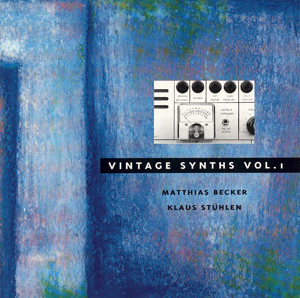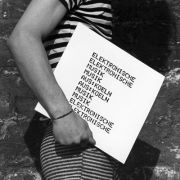
1. Arp Odyssey (1:54)
By the integration of ring modulator and noise generator the Arp Odyssey is quite an impressing instrument capable of some very interesting sounds. We did not find it difficult to make the instrument deliver lots of percussionlike sounds and so this song is a very rhythm-orientated one. Created with the aid of C-LAB NOTATOR und Roland MPU-101.
2. Yamaha CS-60 (3:45)
In matters of sound the instruments of Yamaha's CS-series differ a lot from synths of other manufacturers. The combination of voltage controlled high- and lowpass filter and the very comprehensive LFO-section make this an instrument with a very unique character. No MIDI, therefore played by hand.
3. Oberheim SEM (2:04)
Because the SEM ( "synthesizer expander module" ) by Oberheim comes without noise generator, ring modulator and with only a very basic modulation-section it is only able to produce very clean and very beautiful sounds. The composition was realized without computeraid but with the help of a digital delay with a very long delay time.
4. Korg Mono-Poly (3:16)
A sequence generated by the instruments arpeggiator forms the nucleus of this composition. The sounds used here show that Korg's Mono-Poly can be a very flexible musical tool. Done by hand.
5. Minimoog (1:59)
Naturally here you hear all the stuff which has made the minimoog famous: punchy basslines, very percussive sounds, modulation effects and - last not least - the obligatory solo with pitch bend. Realized with NOTATOR und MPU-101.
6. Memorymoog (4:48)
Because this instrument got its fame mainly for his extraordinary bass and brass sounds you could well call the sounds featured here very untypical for the instrument. We chose them deliberately to make clear that each synthesizer is able to produce lots of sounds beyond the well known clichées. No MIDI-Interface.
7. Roland Jupiter 8 (2:42)
Surely one of the great classic synths because of his extreme variety in terms of sound, realtime editing and very easy programming the Jupiter 8 is a very recommendable instrument which is still in use in lots of professional studios around the world. Because of the excellent MIDI- interface by Groove Electronics not yet being available at the time of recording all the tracks you
hear were played by hand.
8. Yamaha CS-60 (2:07)
This second composition for Yamaha's CS-60 demonstrates even more sound possibilities of this interesting instrument already featured in track no.2.
9.
Sequential Pro One (2:58)
Without any doubt the Pro One would also have been able to play such kind of composition as the one for which we used the ARP Odyssey but our instrument was not 100% tuned by the time of recording so we decided to do a composition that gave us more freedom in terms of tuning.
10. Korg PS-3100 (3:27)
This all-polyphonic instrument also has quite a destinctive character. Especially typical for the PS-3100 are the sound of the filters and the feature of amplitude modulation. Handmade.
11. Roland SH-5 (3:38)
In spite of it's monophonic design and its (only) 12 dB filters this synthesizer from 1976 offers a large number of very different and very convincing tone colours and was one of the sonic surprises of the project. Handcrafted.
12.
Rhodes Chroma (2:15)
The recording of this invention was made with the help of NOTATOR, Wieschiolek-MIDI- Interface and MPU-101. Though without any doubt this track is very interesting musically the sounds used here are in deed very common and those of you looking for more special Chroma Sounds should therefore listen to take no. 18.
13. Korg Poly 800 (2:18)
A small lightweight synth which even can be run on batteries and which in regard to sound is capable of a lot more than one usually expects. Linking to MIDI equipment is no problem at all because of its integrated MIDI interface.
14. Roland System 100 (2:39)
Similar in sound to Roland's SH-5 which is not much of a surprise because both instruments feature the same filter circuitry. Played by hand.
15. Roland
Juno 60 (3:18)
Specialities of this synthesizer are without question its stunning organ replicas, its powerful sound and its very userfriendly editing and programming abilities. Recorded with the help of NOTATOR and Roland MD-8 interface.
16. Mellotron (1:39)
The recording of this short piece of music happened to be very difficult because of the mellotrons wellknown tuning instabilities. To solve the problem we did not use the M 400 of my collection but a Novatron with a quartz-stabilized motor. Unfortunately this also could not overcome our tuning problems, perhaps because of worn out tapes. So we were finally forced to sample the sounds and realize the composition via sampler, computer and MIDI. But still it
sounds like a mellotron, doesn't it?
17. EMS Synthi A (2:17)
The EMS AKS is worldfamous as a "special effects synth" and today Brian Eno still uses it for the sonic editing of sounds. The composition featured here clearly proves that the EMS AKS indeed is a weird little monster. Done by hand.
18. Rhodes Chroma (3:41)
The sonic resources of the Chroma are demonstrated here to quite a larger extent than on track no.12. The fact that in spite of its excellent sound this machine today is used only very seldom in professional studios may be due to it's very complicated programming. Recorded with the aid of Wieschiolek-MIDI-Interface und NOTATOR.
19. PPG Wave 2.2 (3:16)
Together with the Chroma, both Moog synthesizers, the Korg PS-3100, the mellotron and the Yamaha CS-60, the PPG Wave 2.2. is without doubt one of the most impressive electronic beasts presented in this collection. The Wave offers lots of sounds you are not able to produce with any other instrument. Recorded with NOTATOR.
20. Yamaha CS-15 (2:49)
After the SH-5 the CS-15 was the second sonic surprize for us. Small but excellent. Played by hand.
21. Korg MS-20 (2:46)
This probably is the first waltz ever recorded in which all the sounds were generated by a Korg MS-20. Quite typical here: the "peaky" sound of the filters. Handmade.
22. Moog System 55 (2:38)
We finish our journey through yesterdays synthesizer wonderland with a reprise of composition no.1. Typically Moog are the bass sound and the special sounds produced with the help of the fixed filter bank. The solo sound which seems to be a melange of koto and guitar even did surprise us. Unfortunately we probably won't be able to reproduce this sound a second time. Recorded with NOTATOR und Roland MPU-101.
Credits:
all music composed by Klaus Stühlen except: tracks 1, 3, 16 and 22 (music: Klaus Stühlen & Matthias Becker) and track 17 (music: Matthias Becker)_produced by Matthias Becker © ORIGINALTON WEST 1990.
Editing for Compact Disc: John Cremer Layout: Andrea Küffner_we'd like to thank all those who contributed to the realization of this CD, especially: Dirk Matten, Dieter Roggendorf und Achim Lenzgen of SYNTHESIZERSTUDIO BONN, Hans Faßbender und Klaus Weber of MUSIC CITY Cologne, Thomas Wieschiolek of EES und last not least Hans Niederberger for his support concerning the novatron.
